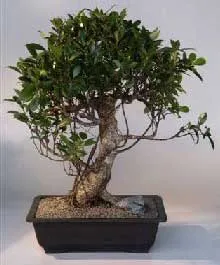The Forgiving Ficus Bonsai
 The ficus or fig is a tremendously popular bonsai tree species. They are tolerant of low light conditions, overwatering, and beginner mistakes. For these reasons it is often recommended as a beginner bonsai or indoor bonsai tree. Other popular features include its interesting surface roots and aerial banyan roots that can develop and hang down from its lower branches. This is why they are so often used in root over rock styles. This article will go into more detail on how to care for ficus bonsai.
The ficus or fig is a tremendously popular bonsai tree species. They are tolerant of low light conditions, overwatering, and beginner mistakes. For these reasons it is often recommended as a beginner bonsai or indoor bonsai tree. Other popular features include its interesting surface roots and aerial banyan roots that can develop and hang down from its lower branches. This is why they are so often used in root over rock styles. This article will go into more detail on how to care for ficus bonsai.
Light requirements for a ficus
Ficus can grow in a wide range of lighting conditions. Some varieties can grow in as low as 800 lux, a measure of light intensity, but most varieties need 1,000 to 2,000 lux. This is one of the lowest light requirements of all bonsai making it one of the least difficult species to keep indoors. However, unless the ficus is kept near a window (west or south facing) or fluorescent light it may be hard to provide it with the light it needs. For some perspective, consider that a normal office without windows is about 400 lux. The minimum lux needed for photosynthesis is about 500. As a result, keeping the ficus within 3 feet of a window will help to make sure it receives the light it needs. This is because outdoors on a sunny day the light intensity can be over 50,000 lux and the intensity of that light coming through the window will decrease by about half every 3 feet from it.
Additionally, placing LED grow lights near the tree will help ensure it receives enough light. The less expensive Sansi and Mars lights shown at that link work well for growing ficus bonsai indoors. A ficus will respond to low light conditions by increasing its leaf size and producing more chlorophyll. It will also grow more leggy. Light levels should be increased if one wishes to encourage smaller leaves with compact growth which helps with scale and proportion. Ficus will thrive in high lighting.
Watering and feeding your ficus
Ficus including salicifolia and neriifolia are not very hard to water. This is a good quality for a beginner bonsai to have as many beginners to the hobby tend to kill their first tree by over or under watering the tree. The tree will be happy as long as it isn't allowed to completely dry out. Ideally keep the soil moist and mist the tree daily. The key is to keep it moist but not wet as that leads to root rot. Ficus will usually let one know they are being overwatered by dropping leaves. Fertilizing can be done by mixing in a half strength liquid fertilizer when the tree is watered every 2 to 4 weeks.
Temperature and Growing Range
Ficus are tropical and do well in USDA zones 10-11. They grow exceptionally well in Florida where it is sunny and the temperature rarely gets very low. Ficus do not like temperatures below 50 degrees Fahrenheit and should be brought indoors in areas with cold winters.
Repotting Ficus
Ficus' vigorous growth does not only occur above ground. Their roots grow just as quick. In order to prevent the tree from becoming pot bound it can be necessary to repot and root prune the tree every year. Fig do not require more than a basic bonsai soil that is aery and drains well. The pot should have good drainage.
How do I make the leaves smaller on my ficus bonsai?
The leaves on ficus trees, especially ficus benjamina, can be a little on the large side for proper perspective on smaller bonsai styles. There are a couple things one can do to encourage the tree to grow smaller leaves. First, increase the amount of light. As mentioned earlier, the ficus will produce smaller leaves and more compact growth in response to higher lighting conditions. Second, techniques such as defoliation and leaf pruning can be used. However, defoliation is hard on a tree and should only be used on healthy trees usually no more than a few times per year.
Why is my ficus losing its leaves?
Ficus may drop their leaves in response to stress. If the tree was recently moved it may lose leaves, but as long as the new location is suitable the leaves should quickly regrow. Leaf drop may also occur if the tree is being overwatered or if the soil is allowed to overdry. Ficus have also been known to drop leaves when a cold front comes through. Lastly, check for insect infestation if any of the other causes don't seem the be the cause.
